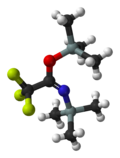| |||
| Names | |||
|---|---|---|---|
| IUPAC name trimethylsilyl 2,2,2-trifluoro-N-trimethylsilylethanimidate | |||
| Other names BSTFA, N,O-Bis(trimethylsilyl)trifluoroacetamide | |||
| Identifiers | |||
3D model (JSmol) | |||
| ChEBI | |||
| ChemSpider | |||
| ECHA InfoCard | 100.042.807 | ||
PubChem CID | |||
CompTox Dashboard (EPA) | |||
| |||
| |||
| Properties | |||
| C8H18F3NOSi2 | |||
| Molar mass | 257.403 g·mol−1 | ||
| Appearance | colourless liquid | ||
| Density | 0.96 | ||
| Melting point | −10 °C (14 °F; 263 K) | ||
| Boiling point | 45–55 °C (113–131 °F; 318–328 K) 14 mm Hg | ||
Except where otherwise noted, data are given for materials in their standard state (at 25 °C [77 °F], 100 kPa). | |||
N,O-Bis(trimethylsilyl)trifluoroacetamide (BSTFA) is an organosilicon compound. It is a colorless liquid that is very sensitive to traces of water or alcohols.
It is often used to convert hydroxyl groups to trimethylsilyl ether groups (Me = CH3):
- ROH + CF3C(OSiMe3)NSiMe3 → CF3C(O)NH(SiMe3) + ROSiMe3
These silylated derivatives are amenable to analysis or further manipulation. Siloxanes are invariably more volatile than their hydroxyl precursors, and thus they can be more easily analyzed with gas chromatography. [1]
This reagent was first reported in 1968. [2]

